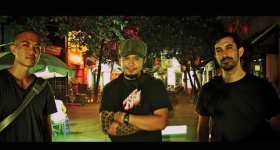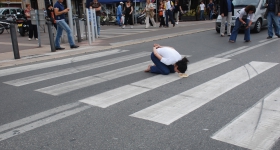AT SAN DIEGO'S Comic-Con International, the nation's largest comic book convention, Michael Paulson trembles with excitement as he watches Tony DeZuniga putting pencil to paper. "Oh my God! I'm so excited; my pants are going to explode! Nobody does pencils like Tony DeZuniga anymore. Tony's a legend!" Paulson says.
A few deft, masterful strokes later and he's drawing Jonah Hex, the gun-slinging comic book anti-hero he helped create for DC Comics over 30 years ago.
DeZuniga still reaps the recognition associated with Hex and from a career as a comic book artist that started in the 1960s and has spanned four decades. It has included stints at DC Comics and Marvel, where DeZuniga co-created characters like Hex and Black Orchid and drew characters like Conan, Thor, Punisher and the X-Men.
The adulation of comic book fanboys aside, these are heady times for DeZuniga. A Jonah Hex movie is currently in development, a stamp featuring DeZuniga's Spider-Woman art was released by the US Postal Service and two separate action figures based on DeZuniga's art have been created-a Spider-Woman figure by Marvel, which was released in 2007, and the official Tony DeZuniga Jonah Hex Action figure due out later this year from DC Comics.
In addition, San Francisco-based artists Leroid David and Matt Abaya are currently producing a documentary entitled American Komikeros, which chronicles the history of Filipino comic book artists in the United States and features DeZuniga's pioneering rale as the leader of the "Filipino Invasion" of American comics.
DeZuniga says he wouldn't trade his career in comic books for anything, because nothing beats the thrill of creating a character that resonates with audiences and stands the test of time.
"I didn't know Hex would be so successful," De Zuniga says. "I had a doctor's appointment, and I was sitting there, and I saw a anatomy chart with all the muscles and tendons and everything exposed and the light bulb went on and I said, 'I'll draw that!' In comics in those days, everything was 'weird' this and weird' that, 'Weird Tales' and 'Weird Western,' so I guess I was influenced by some of that," DeZuniga says.
Thus was born Jonah Hex, the gunslinger with the mutilated face who revolutionized a "Wild West" comic genre that had grown stale, due in part to heavyhanded censorship from the Comics Code Authority, which required that blood be drawn in black ink instead of red ink. This was back in the day when Comics Code officials would do things like send back panels asking that artists redraw puffs of smoke emanating from gun barrels because they were too large and therefore "too violent."
When asked if he thinks today's sometimes hyper-violent comic books are too graphic, DeZuniga says, "No. I think they're great. Before Jonah Hex, the cowboys were always shooting guns out of the bad guy's hands. But not Jonah Hex; when he shot someone-BLAM!-they were dead and that was it. I think that's why people liked it because it was more realistic," DeZuniga says.
DeZuniga is particularly beloved in the Philippines because of the way he parlayed his success into opportunities for other immigrant Filipino artists. Upon hearing that DC was willing to pay $12 a page for new art, DeZuniga immediately saw a way to recruit other talented comic book artists from the Philippines, many of whom were laboring long hours for as little as 50 cents a page.
DeZuniga convinced DC Comics executives Carmine Infantino and Joe Orlando to visit the Philippines in 1971. Once there, DeZuniga rounded up local talent. As a result of his efforts, quite a number of Filipino artists began working in the US comics industry, including such luminaries as Alex Nino, Alfredo Alcala, Nestor Redondo, Fred Carrillo, Vicatan and Gerry Talaoc.
The Filipino artists DeZuniga recruited made the most of their opportunities and even broke new ground by using an early form of "telecommuting." By using DHL's courier service, they were able to get completed art from Manila to New York in only 12 hours. Recounting how DC's editors would often chide New York-based artists for being slow compared to the Filipino artists, DeZuniga says, "They would ask the artists, 'How is it that these artists can get us their art faster than you, when they're in the Philippines and you're in Brooklyn?'"
DeZuniga's thoughtfulness opened the doors and the comic book industry has had more than its share of successful Filipino artists ever since. One contemporary artist, Gerry Alanguilan, created the Philippine Comics Art Museum at www.komikero.com, which is a website that preserves and celebrates the proud history of Filipino comic book artists.
Many modern Filipino comic book artists have been influenced by their immigrant predecessors' artistic legacies. Before a recent move to Los Angeles, DeZuniga continued to hold regular gatherings at his Stockton, CA, art studio, where young Filipino artists come and benefit from his guidance and enjoy feasts of lumpia and noodles provided by DeZuniga's wife, Tina.
One such artist, Mike Dimayuga-whose original comic book Hero House is expected to be published and distributed nationwide by Arcana Studios later this year-showed DeZuniga his portfolio at a comic convention and was surprised by the thoughtful, helpful critique he received. Dimayuga was subsequently invited to attend drawing sessions at DeZuniga's Stockton studio and credits DeZuniga with helping provide him with the "boost and the kick in the pants that I needed to realize that my dreams are achievable after all. It is a tough industry to get into, but meeting Tony has shown me that I can do it."
I.G. Ramirez is an award-winning journalist who has written for many major metropolitan newspapers. He accidentally stumbled into the wonderful world of Filipino comic book aft after discovering artist Mike Dimayuga 's website at www.theothermike.net.
I.G. RAMIREZ began to investigate Filipino comic books artists after he wrote a short story about an anthropomorphic Aztec Tapir, and someone suggested it would make a good comic book. "I hadn't read a comic book in over 20 years," he said. "I was surprised how far comic books had come and inspired by the new directions creators like Frank Miller, Alan Moore and Neil Gaiman were taking the medium." Ramirez has written for many newspapers, including the San Jose Mercury News, The Dallas Morning News and the Arizona Republic.









Comments